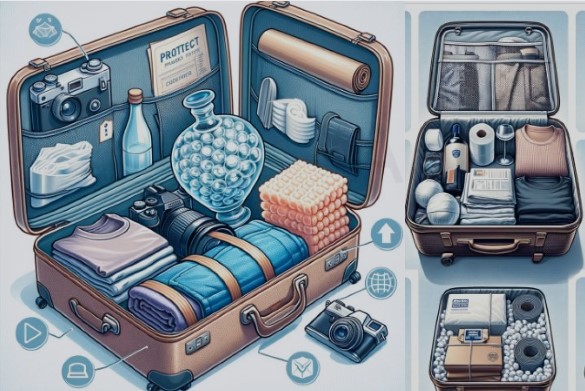How to protect fragile items in a suitcase?

In this step-by-step guide, we will learn how to effectively protect fragile items in a suitcase. Traveling can be an exciting adventure, but it can also be a challenge when it comes to keeping delicate items safe. Whether you’re packing delicate souvenirs, expensive gifts, or sentimental objects, it’s crucial to take the necessary precautions to prevent any damage during your journey. By following these simple steps, you’ll be able to ensure that your fragile items arrive at your destination in one piece. So let’s get started and make sure your valuables are well-protected on your next trip! 11 Things to Do at Home Before Going on vacation
Table of Contents
Travel in Style with Our Top Picks!



Master the Art of Travel Packing: Safely Transport Fragile Items with Expert Packing Tips
1. Choose a sturdy suitcase
Choose a suitcase made of durable material that can withstand rough handling. Look for suitcases made of materials such as polycarbonate or nylon, which are known for their strength and resilience. Avoid suitcases made of cheap, flimsy materials that could easily get damaged or torn during travel.



2. Wrap fragile items individually
To wrap fragile items individually, follow these steps:
- Gather the necessary materials: bubble wrap and tissue paper.
- Place the fragile item in the center of a sheet of bubble wrap or tissue paper.
- Fold the sides of the wrap over the item, ensuring all edges are covered.
- Secure the wrap by tucking the sides under the item or using tape if necessary.
- Repeat this process for each fragile item, wrapping them separately.
- Make sure there is enough cushioning around each item to prevent any movement or breakage during transit.
- Once all the fragile items are wrapped, place them in a sturdy box, making sure to leave enough space for additional cushioning materials if needed.
By following these instructions and wrapping each fragile item individually, you can ensure that they are well-protected and minimize the risk of breakage during transportation. Remember, taking the time to wrap each item properly will provide an extra layer of cushioning and help preserve your fragile belongings.
3. Separate fragile items with clothing or towels
To prevent fragile items from bumping into each other and potentially breaking during transportation or storage, place clothing or towels between them. This creates a protective barrier and cushions the impact. For example, if you are packing a box with delicate glassware, wrap each piece individually with a cloth or towel, and then place additional clothing or towels between the items. This method ensures that the fragile items are properly separated and reduces the risk of damage.
4. Utilize packing organizers
To utilize packing organizers effectively, start by using packing cubes or compression bags to maximize space in your suitcase. Place fragile items inside the organizers to ensure they stay secure and protected during travel. This will minimize movement inside the suitcase, preventing potential damage. Make sure to neatly arrange and stack the organizers in your suitcase for easy access and efficient packing.



5. Pack fragile items in the center of the suitcase
Position fragile items in the middle of the suitcase to provide additional protection from external impacts. Start by placing a layer of clothing or soft items at the bottom as padding. Then, carefully wrap each fragile item in bubble wrap or clothing, securing with tape if necessary. Place these wrapped items in the center of the suitcase, surrounded by more clothing or soft materials to minimize movement. Finally, close the suitcase and ensure it is securely fastened before your journey begins.
6. Fill empty spaces with soft items
Fill any empty spaces in the suitcase with soft items like socks or scarves. This simple step will help prevent fragile items from shifting during transit. Fold your socks or scarves neatly and tuck them into any gaps or crevices in your suitcase, ensuring a snug fit. By doing so, you’ll add an extra layer of protection to your delicate belongings and ensure they arrive safely at your destination.
7. Label the suitcase as fragile
Attach a ‘fragile’ label to your suitcase before checking it in. This label will help baggage handlers identify the delicate nature of your belongings and handle your suitcase with extra care. Simply peel off the back and stick the label prominently on a visible side of your suitcase. This small action can go a long way in ensuring the safe arrival of your items at your destination.
8. Secure the suitcase with TSA-approved locks
Secure your suitcase and ensure unauthorized access is prevented by using TSA-approved locks. These locks are specially designed to allow security officials to inspect your luggage when required, without causing any damage to your locks or suitcase. Simply purchase TSA-approved locks and follow the manufacturer’s instructions to set the lock combination. Attach the locks securely to your suitcase’s zippers or clasps, and relax knowing your suitcase is protected and that security officials can easily inspect it when necessary.
9. Choose a direct flight if possible
Choose a direct flight to minimize the number of times your suitcase is handled and reduce the risk of damage to fragile items. By selecting a non-stop flight, you can ensure that your baggage stays safe throughout the entire journey. For example, instead of taking a connecting flight from New York to Los Angeles, opt for a direct flight that will transport your suitcase directly to your destination without the need for multiple transfers.
10. Handle the suitcase with care
When handling your suitcase, it is important to follow these steps:
- Lift the suitcase properly: Bend your knees and use your leg muscles to lift the suitcase, rather than putting strain on your back. Keep your back straight and hold the handles firmly, distributing the weight evenly.
- Avoid dropping or throwing: Dropping or throwing your suitcase can cause damage to fragile items inside. Instead, gently place the suitcase down on a flat surface. If you need to place the suitcase in an overhead compartment or on a luggage rack, do it with care to prevent any sudden impact.
- Protect fragile items: If you have delicate items inside your suitcase, consider using additional padding or protective materials, such as bubble wrap or clothing, to prevent them from getting damaged. You can separate fragile items from heavier objects and cushion them within the suitcase by placing them in the middle or surrounded by soft materials.
- Examples: For instance, if you have a fragile souvenir or a glass bottle, wrap it in bubble wrap or old clothing before placing it in your suitcase. You can also stack soft clothing around it to provide extra protection. Similarly, if you have a laptop or other electronic devices, use a padded sleeve or wrap it in a soft cloth and position it securely within the suitcase.
Remember, handling your suitcase with care not only ensures the safety of your belongings but also keeps you organized and stress-free during your travels.
Wrap with care!
In conclusion, effectively protecting fragile items in a suitcase is crucial to ensure their safety during travel. By following the simple steps outlined in this guide, such as using proper packaging materials, strategically placing the fragile items, and utilizing additional cushioning, you can significantly minimize the risk of damage. Remember to always prioritize the safety of your fragile belongings when packing your suitcase. With these valuable tips in mind, you can confidently journey to your destination, knowing that your precious items are secure. So go ahead, pack with care, and enjoy your travels worry-free!
Essential Supplies
- Sturdy suitcase
- Bubble wrap
- Packing tape
- Clothing or towels
- Packing organizers
- Soft items (e.g. socks
- scarves)
- Fragile labels
- TSA-approved locks








Guarding Your Delicates
- Choose a sturdy suitcase: Invest in a suitcase that is durable and made from hard shell material for better protection of fragile items
- Wrap fragile items individually: Use bubble wrap or tissue paper to wrap each delicate item separately. This will minimize chances of them rubbing against each other and breaking
- Use packing peanuts: Fill the empty spaces in your suitcase with packing peanuts to provide cushioning and prevent items from shifting during travel
- Place delicate items in the center: Position fragile items in the middle of the suitcase, away from the edges, to provide extra protection from external pressure
- Separate fragile items with clothing: Layer clothing between delicate items to create a buffer zone and absorb any impact during transit
- Consider using packing cubes: Utilize packing cubes to compartmentalize and organize your items, reducing the risk of fragile items colliding with each other
- Keep fragile items away from heavy or sharp objects: Make sure fragile items are shielded from heavier objects or anything with sharp edges, to minimize the risk of damage
- Secure items with elastic bands: Wrap elastic bands around bundled items to keep them tightly together, preventing any unnecessary movement
- Mark your suitcase as fragile: Indicate that your suitcase contains fragile items by attaching a “fragile” label or sticker. This may encourage more careful handling by airport staff
- Carry delicate items with you: If possible, consider carrying your fragile items in a separate bag within your carry-on luggage instead of putting them in the checked baggage
Effortless Organization and Stress-free Packing: Mastering the Art of Using Your Suitcase
- Start by choosing a sturdy and reliable suitcase that suits your needs. Look for one with convenient features like wheels, a telescopic handle, and multiple compartments
- Before packing, make a checklist of the essential items you will need during your trip. This will help you prioritize what to pack and ensure you don’t forget anything important
- Fold your clothes neatly to maximize space and minimize wrinkles. Utilize packing cubes or compression bags to further optimize space and keep your belongings organized
- Pack toiletries and other small items in leak-proof containers or sealable bags to prevent spills and keep everything in order
- Place heavier items at the bottom of your suitcase to create a stable base. Place delicate items or items you need quick access to at the top
- Utilize the space inside your shoes by stuffing them with socks or small items. This will save space and help maintain the shape of your shoes
- Use the internal and external pockets of the suitcase wisely to keep your belongings organized and easily accessible
- Don’t forget to secure your suitcase by using locks or luggage straps for added security during your journey
- Finally, double-check your packing list before closing your suitcase to ensure you haven’t missed anything important
Frequently Asked Questions: How to protect fragile items in a suitcase
Have you ever considered the significance of what you choose to leave behind when you pack your suitcase?
Absolutely! When you pack your suitcase, it’s not just about the things you take with you, but also about what you choose to leave behind. In fact, the significance of this decision cannot be underestimated.
Every item we bring on our journey, no matter how big or small, carries a meaning or a memory. It’s not just about practicality, but also about the emotions and experiences associated with those belongings. They become a part of our personal narrative, a reflection of who we are and what we value.
Choosing what to leave behind is also a chance to evaluate what truly matters to us. It’s an opportunity to de-clutter our lives and prioritize what is essential. By leaving behind unnecessary baggage, both physical and metaphorical, we create space for new experiences, new perspectives, and new opportunities.
Moreover, what we choose to leave behind can have a profound impact on the people and places we visit. It can be a gesture of generosity by leaving items that may be useful for others, or it can be a way to show respect for local customs and traditions. By making thoughtful choices, we can contribute positively to the communities we encounter.
So, next time you pack your suitcase, I encourage you to consider the significance of what you choose to leave behind. It’s not just about the practicality of packing efficiently, but about the meaningful impact our choices can have on ourselves and the world around us. Let’s strive to leave behind positivity, inspiration, and a sense of purpose wherever we go.








– One suggestion I would add is to invest in some bubble wrap or packing paper to provide extra cushioning for fragile items. It can really make a difference in terms of keeping them safe during the journey.
– I would love to see some additional suggestions for protecting fragile items, especially when traveling by airplane. Are there any specific regulations or guidelines that we should keep in mind?
– I found this article very informative and useful. I have always struggled with packing fragile items in my suitcase and this article provided me with some excellent tips and strategies to keep them protected. Thank you!